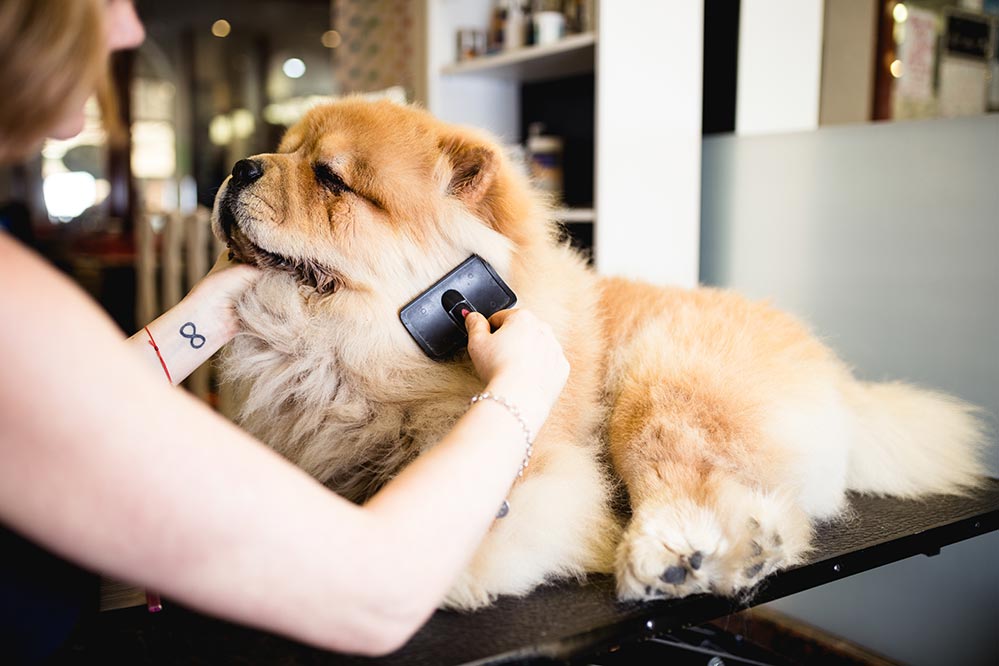AKC is a participant in affiliate advertising programs designed to provide a means for sites to earn advertising fees by advertising and linking to akc.org. If you purchase a product through this article, we may receive a portion of the sale.
Some dogs, like Labrador Retrievers, Newfoundlands, and Pekingese tend to shed a lot. Others, like Dachshunds, Poodles, and Border Terriers seem to be almost shed-free. There are reasons why some dogs shed and others don’t shed at all. But how do you deal with dog shedding?
Different dog breeds shed in different amounts: Some shed seasonally, while others shed year-round. This depends on the type of coat your dog has. A Golden Retriever, for example, has a thicker double-coat, which makes it more likely to shed year-round.
For dogs that shed seasonally, you’ll notice that most shedding occurs in the spring and fall. In the spring, your dog’s coat will become lighter, in preparation for the warm weather. Similarly, in the fall, in preparation for winter, you will see a change in your dog’s coat and a higher incidence of shedding.
For dog’s who shed often, it is important to brush them – sometimes weekly, sometimes a few times a week, or sometimes daily during periods of heavy shedding.
Even if your dog is not a big shedder, it is still important to brush and groom dogs regularly, but how often you groom depends on their coat.

Choosing a Brush for your Dog
Choosing the right brush can help in your grooming process, especially if your dog sheds frequently.
For dogs with shorter coats (think Beagles, Pugs, or German Shorthaired Pointers):
- You can do a fine job of loosening dead hair and setting it free with a natural-bristle brush or even a grooming glove with bristles on the palm.
- First brush the coat in the opposite direction of hair growth, to pull dead hair out, then brush in the direction of hair growth to remove it. Repeat this process a few times to get out all the hair and to distribute the natural oils from the skin all over the coat.
- If using a hound mitt or glove, massage the coat in a circular motion to loosen hair, then “brush” (i.e., “pet”) in the direction of hair growth. Repeat a few times, especially when shedding is heavy.
For dogs with longer coats – Especially for double-coated dogs – the ones with a downy undercoat beneath a harder outer coat, such as Pomeranians, Collies, and Pembroke Welsh Corgis:
- You need a tool that can reach down under that outer coat to grab the downy undercoat and pull out the dead hairs. Slicker brushes are excellent tools for such dogs. Go over the coat in both directions a few times, until you’re pulling out less and less hair from the brush.
- When shedding really picks up, especially with the double-coated breeds, switch over to a coat rake or shedding tool. They all work a little differently, but basically, you pull the tool along the coat in the direction of hair growth, then pull up and away. For shedding tools with blades, don’t press too hard. If you run across any tangles or mats, pick these out with a steel comb or use a mat splitter.
Sometimes underlying endocrine disorders such as hypothyroidism or congenital problems such as follicular dysplasia can cause excessive shedding. It is also possible your dog may have allergies, and this can cause skin and shedding problems.
If you think your dog may have a skin problem, talk to your veterinarian.
Otherwise, the most effective method to combat shedding is to remove dead hair with regular brushing, combing, and the use of shedding controlling shampoos and baths. Some dogs even enjoy being “vacuumed”!

